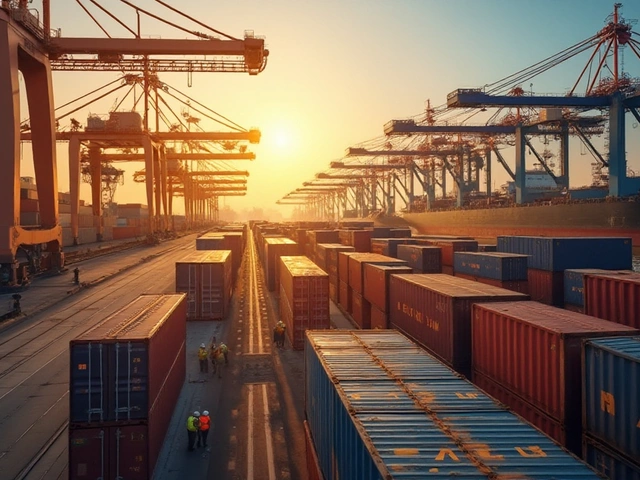Ever picture a warehouse as just rows of dusty shelves and a tired forklift humming around? That’s yesterday’s story. Today, even the smallest stockrooms are pulsing with technology that quietly tracks, shifts, and counts every single item—often with the help of a warehouse management system (WMS). So, who’s actually using this tech? Let’s start peeling back the layers, because if you think WMS is only for big, shiny Amazon-sized warehouses, think again.
What is a Warehouse Management System—and Why Does Anyone Need One?
Picture this: trucks rolling in, totes of products stacked sky-high, and every single order expected to ship today, not tomorrow. That chaos used to be normal in the supply chain world. Then the warehouse management system arrived. A WMS is a type of software specifically built to organize, control, and monitor warehouse operations. We're talking receipts, putaways, picking, packing, shipping—the whole deal, optimized and streamlined.
So why do people use one? The answer is brutal: human error loves chaos, and chaos hates profit. In a real 2023 survey by Gartner, 78% of supply chain execs said inventory mistakes were their top headache. A WMS steps in like a silent traffic cop, making sure items don’t get lost, sold twice, or forgotten on a dusty top shelf. If you’ve ever received a pair of shoes in the wrong size from an online order, you’ve witnessed a warehouse without good software.
There’s more. WMS platforms can speed up picking by as much as 40%, according to Zebra’s 2024 logistics study. That’s not just nice to have—it could turn the tide for businesses with razor-thin profit margins. Now, automated alerts ping when products are about to expire. Robotic arms sync with barcode scanners. Cloud-based dashboards give managers split-second inventory views, so one guy on the other side of the planet knows when they’re running low on rubber ducks.
At its core, a WMS saves money, time, and people’s sanity. Small wonder the global WMS market is worth over $4.5 billion as of 2025. But who’s actually plugging in and using this tech?
The Power Users: Warehousing’s Big Players and Fast Movers
You might guess that WMS is the playground of eCommerce titans—giants like Amazon, Alibaba, and Walmart. And you’d be right: these businesses couldn’t run their hyper-efficient operations without a finely-tuned web of warehouse software. Amazon’s fulfillment centers are estimated to move more than 18 million packages every single day globally. No human could juggle that without digital help.
But here’s the twist—giant online sellers aren’t the only players. Third-party logistics providers (3PLs) are some of the thirstiest WMS users out there. Since these companies ship, receive, and store goods for dozens (sometimes hundreds) of different brands at once, they need a scoreboard that keeps everything straight. For 3PLs, a glitchy WMS doesn’t just mean late deliveries. It means upset clients, lost revenue, and a spotty reputation in a shrinking field. One survey from Inbound Logistics found 94% of 3PLs reported increased efficiency after switching to a digital WMS platform.
Retailers with physical shops—think Target, Best Buy, and even mid-tier grocery chains—lean hard on WMS, too. When you don’t see empty shelves at a store during Black Friday, you can bet the software behind the scenes is working overtime. Even manufacturers—those crafting everything from cereal to circuit boards—run sophisticated WMS solutions to keep raw materials and finished goods on the right tracks. For a company like Toyota, the difference between a missing car part and a completed order can mean millions lost. That’s why 75% of Fortune 500 manufacturers use some kind of tailored WMS (source: 2025 Supply Chain Review).
| Industry | Typical WMS Usage | Adoption Rate (estimate) |
|---|---|---|
| eCommerce & Online Retail | Inventory and orders, returns, replenishment | 99% |
| Third-Party Logistics (3PL) | Multi-client inventory, billing, compliance | 94% |
| Traditional Retailers | Stock control, replenishment, loss prevention | 81% |
| Manufacturers | Raw material tracking, finished goods | 75% |
| Food & Beverage | Expiration, batch, and lot control | 78% |
| Pharmaceutical | Regulatory compliance, sensitive stock | 83% |

Small Businesses and Surprising Niche Users
Think you need a massive warehouse the size of 10 football fields to use a WMS? Not a chance. Smaller sellers—indie brands, family-owned shops, local suppliers—are jumping on board too. Cheap cloud-based WMS subscriptions mean you don’t need a huge IT team or server room. Platforms like ShipBob and Fishbowl make stock control as easy as a grocery list on your phone.
Take local breweries, for example. A 2024 survey by the Brewers Association found that a full 61% of breweries with under 50 employees use some kind of digital tracking, often a light WMS, for kegs and ingredient stock. The reason? Freshness matters—nobody wants stale beer, so keeping tabs on lot numbers and rotation dates is what keeps customers coming back. It’s the same for boutique fashion sellers running pop-up shops; they depend on quick-moving, app-based WMS software to track those trending pieces and avoid overstock they’ll never sell.
Non-profits and charities? They’re in the game, too. Food banks and relief organizations use WMS tech to track donations, expiry dates, and distribution so resources get to the right places and nothing goes to waste. Colleges and hospitals—even museums—have jumped on the WMS train to keep tabs on everything from medical equipment to priceless artwork.
Here’s a tip for smaller operations: if you’ve got more than 1,000 items on hand or process more than 50 orders a day, you’ll probably save money—and headaches—switching to a digital WMS. The setup can take just a few days and, with mobile scanning, your team will adapt fast. Choosing the right WMS boils down to listening to your needs: Do you just need barcode management and stock levels, or do you want to dive into forecasting, returns, and automated reordering? If you start simple, most systems let you add features as you grow.
New Trends: How WMS is Evolving and Who’s Next in Line
The WMS world is always shifting, and it’s no longer about just tracking goods. The latest systems are all about intelligence: artificial, predictive, and scalable. The big buzz right now is AI-powered WMS. These don’t just react, they predict. Imagine knowing what you’ll run out of next month before it happens or having your shelves rearranged automatically to speed up next-day shipping. That’s already rolling out at facilities run by giants like DHL and Maersk.
Another trend? Internet of Things (IoT) sensors. With small, cheap sensors tracking temperature, vibration, or humidity in real time, WMS can flag problems the moment a freezer door is left open or when a sensitive medicine is about to spoil. The pharmaceutical sector has nearly universal WMS adoption now—think 90% or more—because regulations demand it. The same shift is starting in food, fashion, and even electronics.
Direct-to-consumer brands (D2C) are the next wave. Any company that ships out those monthly snack boxes or custom sneakers launching on TikTok needs a WMS to keep up. Even micro-warehousing—small, urban stockrooms positioned closer to customers for rapid delivery—is driving new users to WMS, as quick turnaround and hyper-local inventory are the new gold standards.
- Tip: If your business is thinking of jumping in, look for WMS with real-time analytics dashboards and easy mobile access—you’ll make decisions faster.
- Watch for growing integrations: the best WMS platforms now link directly with Shopify, Magento, and Amazon Seller Central, so inventory and orders match up perfectly.
- Want automation without the robot price tag? Check out WMS vendors offering AI-driven picking suggestions and smart task priorities for workers on foot, not just machines.
The next big users of WMS? Think everyone from gig-economy fulfillment centers to restaurant suppliers. If a place stacks, ships, or hands out more than a handful of SKUs a day, there’s probably a WMS humming quietly in the background, keeping things straight. And don't overlook the value: companies using warehouse management system solutions see inventory accuracy improve to 99.5% or higher, according to 2025 data from Modern Materials Handling.





